Buddhist Circuit
Bihar is the land where Gautam Buddha began his search for answers to human suffering and found enlightenment. The legendary spiritual enlightenment site of the Buddha under the Mahabodhi Tree is now occupied by the Mahabodhi Temple, which attracts Buddhist pilgrims and travellers from around the world. This temple complex has also been declared as a World Heritage Site by UNESCO. The Buddhist Circuit is a trail of the sacred footsteps of Lord Buddha and the important places of his life and teachings across Bihar.
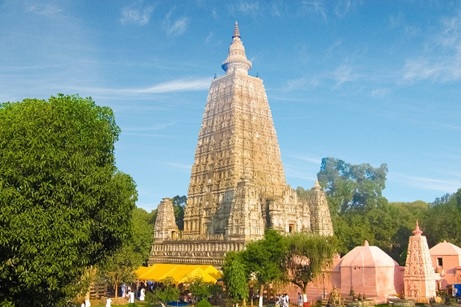
Mahabodhi Temple at Bodhgaya
The Mahabodhi Temple (literally: "Great Awakening Temple"), a UNESCO World Heritage Site, is an ancient, Buddhist temple in Bodh Gaya, marking the location where the Buddha is said to have attained enlightenment. The temple stands in the east to the Mahabodhi Tree. Its architectural effect is superb. Its basement is 48 square feet and it rises in the form of a cylindrical pyramid till it reaches its neck, which is cylindrical in shape. The total height of the temple is 170 ft. and on the top of the temple are Chatras which symbolize sovereignty of religion.
Sujata Stupa at Bodhgaya
Sujata Stupa, also Sujata Kuti stupa or Sujata Garh, is a Buddhist stupa located in the village of Senanigrama (Bakraur) slightly east of Bodh Gaya in the state of Bihar, India. It lies directly across the Phalgu River from the town of Bodh Gaya, where Gautama Buddha is said to have attained enlightenment. The stupa was dedicated to the milkmaid Sujata, from the village of Bakraur, who is said to have fed Gautama Buddha milk and rice at this spot as he was sitting under a Banyan tree, thereby ending his seven years of fasting and ascetism, and allowing him to attain enlightenment.
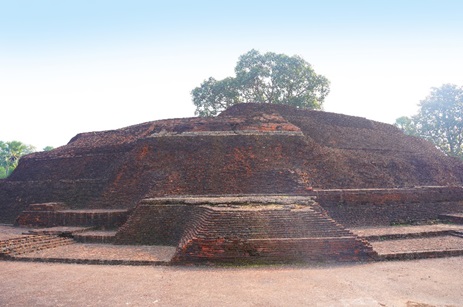
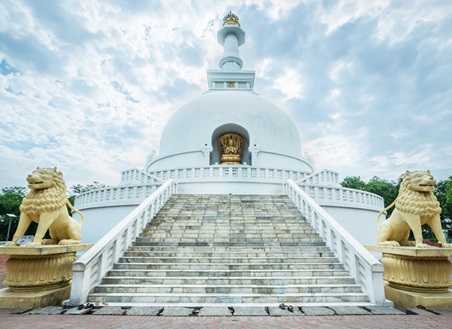
Vishwa Shanti Stupa at Rajgir
Vishwa Shanti Stupa, also called the Peace Pagoda. It is located at the highest point of Ratnagiri hill, at an altitude of 400 m in Rajgir, qualifying its serene charm as divine. Built completely with marble, Stupa comprises four golden statues of Lord Buddha with each representing his life periods of birth, enlightenment, preaching and death. There is a ropeway which helps the tourists reach Vishwa Shanti Stupa a top Ratnagiri hill. The other way to reach this "Stupa" is a serpentine staircase.
Ashokan Pillar, Kolhua Vaishali
Kolhua is a famous Buddhist excavation site situated approximately 65 km North-West of Patna. The excavations have revealed the famous Ashokan Pillar having a statue of lion on the top. Excavations also revealed, many other articles related to Buddhism. Emperor Ashoka built The Lion Pillar at Kolhua. It is made of a highly polished single piece of red sandstone, surmounted by a bell shaped capital, 18.3 m high. A life-size figure of a lion is placed on top of the pillar. There is a small tank here known as Ramkund. This pillar beside a brick stupa at Kolhua commemorates Buddha's last sermon.
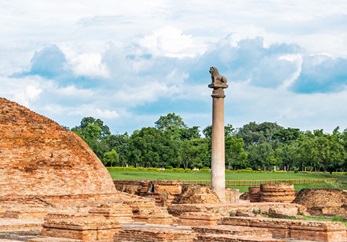
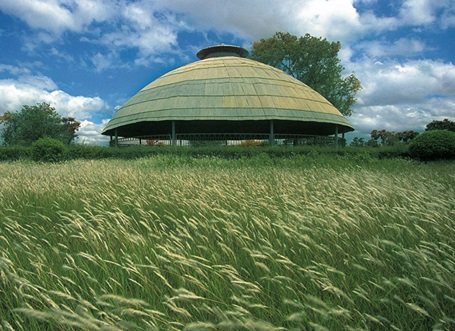
Buddha Relic Stupa at Vaishali
Buddha Relic Stupa, enshrining one of the eight parts of the mortal remains of Lord Buddha after he attained Mahaparinirvana, is one of the most revered sites for Buddhists and a protected one for Archaeological Survey of India (ASI), located around 55km northwest of Patna in Vaishali district. The Buddha Relic Stupa was built by Lichhavis as a mud-stupa in the 5th century BC. The stupa was later discovered in an archaeological excavation carried out under the aegis of Patna-based K.P. Jayaswal Research Institute during 1958-1962. The relic casket excavated from the core of the stupa contained the holy ashes of Lord Buddha mixed with earth, a piece of conch, pieces of beads, a thin golden leaf and a copper punch-marked coin. The casket was brought to Patna Museum in 1972.
Kesariya Stupa at East Champaran
Kesariya came into the limelight after the discovery of biggest ever Buddhist Stupa. Till date it is estimated to be the tallest ever-excavated Stupa in the world. It commands prominent positions in East Champaran from tourism point of view. The stupa is the symbol glorious past of Buddhism era. It has a polygonal base and is capped with polygonal shaped bricks from top.


Ruins Of Vikramshila, Bhagalpur
Situated at Antichak in Kahalgaon sub-division, 38 KM from Bhagalpur, ancient Vikramshila University was famous as a Centre of learning during the Pala dynasty. The university was established by the King Dharmpala. Two things impressed Dharmpala and motivated him to establish the university; first, the rocky hillock anchored around the confluence of the Kosi and Ganga rivers at Bateshwar Sthan was not only a scenic attraction but also a popular Tantric site. Second, the Ganga here was Uttar Vahini (flowing northwards) and as such, the place was a pilgrim center which drew large crowds during Varsavardhana.
